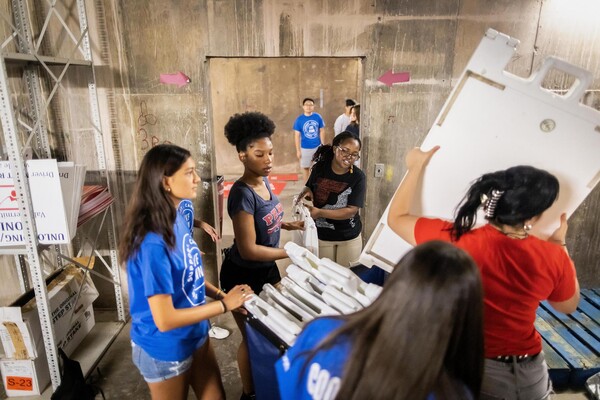Stealing beauty, culture
Penn archaeologist Clark Erickson is an expert on the ancient cultures of Peru and Bolivia. Over the years he’s also become something of an expert on international crime. That was never in his career plan, but the sites he excavates in South America have become major magnets for looters in search of valuable antiquities to sell on the black market.
“You can’t find a site in Peru that doesn’t have tunnels dug by looters,” Erickson told an audience at Penn Museum Jan. 13. Showing slides of a Peruvian landscaped pockmarked with holes, Erickson explained that the looting corresponds with fads in the art world. “In the ’70s and ’80s it was gold. Now it’s textiles.” In search of their precious loot, the criminals toss aside anything else they find—bones, pottery, pieces of mummies—disturbing forever the cultural context so crucial to the archaeologist.
Erickson’s talk was part of a weeklong FBI training session held in Philadelphia for the agency’s newly formed art theft team.
“We’ve never had an art theft squad covering the whole US before,” said FBI Art Theft Program Manager Lynne Richardson, but since trafficking in antiquities has become the third largest crime internationally, the FBI decided to step up operations. “This is truly an international crime problem,” said Richardson, “and lots of items stolen overseas are brought into our market to be sold.”
Also on hand was Philadelphia-based Special Agent Robert Wittman, whose division has recovered more than $100 million in art and cultural property, and Assistant US Attorney Robert Goldman, who will work with the new art theft team to prosecute cases.
Roger Atwood, a journalist and author of “Stealing History: Tomb Raiders, Smugglers, and the Looting of the Ancient World,” in town on a book tour, reminded the audience that Penn Museum has been a leader in fighting the problem of looting. In 1970, the Museum issued the Philadelphia Declaration, a decision to renounce the acquisition of antiquities that lacked written provenance. “This was incredibly courageous,” said Atwood, “and there were no followers in the museum world for a long time. If others had done it 30-odd years ago it would have done a lot to prevent looting and save cultural heritage.”
Penn Museum has also been directly involved in recovering stolen goods. Erickson recalled how late one afternoon in 1997 he was summoned to Philadelphia’s FBI headquarters to identify an object intercepted in a sting operation by Wittman’s team. Sitting on the table, he said, was a flimsy suitcase filled with underwear and cheap towels, and a gold artifact he recognized instantly as a piece of armor from the ancient Moche culture of Peru.
Such collaborations are vital, said Goldman. What is at stake, he continued, is not just the theft of a single object, but the heritage of entire cultures. “Teddy Roosevelt said the task of archaeology is to bring the past into the present. Without these objects we can’t bring the past to our children. It robs future generations.”
Goldman’s job, he said, “is to protect our cultural heritage and return objects, but also to arrest and prosecute and put the fear of God into people.”
Education, said Erickson, who is an associate curator in the Museum’s American Section, is also paramount, whether that’s educating the US public on the seriousness of the issue or educating native cultures on the richness of their own heritage. “Law enforcement,” he concluded, “can only operate to a certain level.”







